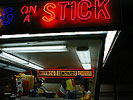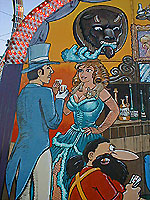the iCite net > news / blog > a permalink
news and thoughts on and around the development
of the iCite net
by Jay Fienberg
Navigating through information crowds: the San Mateo County Fair, part 2
posted: Aug 17, 2003 11:36:44 PM
 This is the conclusion to my previous post, The grand unified theory of TRDBMS, OO, XML, RDF, client/server and the web: the San Mateo County Fair, part 1. Like part 1, part 2 is mostly about the pictures I took yesterday at the San Mateo County Fair.
This is the conclusion to my previous post, The grand unified theory of TRDBMS, OO, XML, RDF, client/server and the web: the San Mateo County Fair, part 1. Like part 1, part 2 is mostly about the pictures I took yesterday at the San Mateo County Fair.
 The Internet is seemingly an infinite domain of information, but nevertheless, meaning remains in relatively short supply. Meaning continues to be crowded into information—the same information can mean a lot of different things.
The Internet is seemingly an infinite domain of information, but nevertheless, meaning remains in relatively short supply. Meaning continues to be crowded into information—the same information can mean a lot of different things.
 It is interesting trying to navigate through large crowds of people. There is a lot of communication going on, most of it through subtle body language. You and another person are approaching each other head-on, and there is no room for anything other than one of you moving one step in one direction and the other moving one step in the other direction: who moves and who moves which way?
It is interesting trying to navigate through large crowds of people. There is a lot of communication going on, most of it through subtle body language. You and another person are approaching each other head-on, and there is no room for anything other than one of you moving one step in one direction and the other moving one step in the other direction: who moves and who moves which way?
 There is a lot of room for misunderstanding the meaning of subtle body language. Gestures can mean different things in different contexts.
There is a lot of room for misunderstanding the meaning of subtle body language. Gestures can mean different things in different contexts.
So, in any language, when there is space to do so, creating protocols is a way to provide a context that overrides the need to discriminate among or interpret the subtleties of meaning. For example, in the US, when two cars approach head-on, the protocol is that each car veers to its right to avoid the other. (In the UK, each car veers to its left, of course.)
 With protocols like this, the need for interpreting meaning is, in some sense, eliminated. At the very least, it is overridden by the protocol: whatever is interpreted, the protocol determines the action.
With protocols like this, the need for interpreting meaning is, in some sense, eliminated. At the very least, it is overridden by the protocol: whatever is interpreted, the protocol determines the action.
In a crowd of people—especially if those people are assembled together out of the diverse contexts of their private or provincial routines of protocol, there is little choice but to navigate in a field where many protocols coexist and, at any given moment, many of them aren't being followed or understood.
 Protocol and the assumption of meaning both affect navigation in the crowd. But, neither protocol nor any assumed or even agreed meanings can stay static. Successful navigation is in the ability to dynamically adapt between the modes of expressing protocol and meaning.
Protocol and the assumption of meaning both affect navigation in the crowd. But, neither protocol nor any assumed or even agreed meanings can stay static. Successful navigation is in the ability to dynamically adapt between the modes of expressing protocol and meaning.
permalink | comments {0} · trackbacks {0}
also available as: rss · rss2 · rdf · atom
Comments and Tracbacks
Note: All comments and trackbacks are moderated. Spam is deleted. Other comments are approved as promptly as possible.
Note: Older posts no longer accept new comments or trackbacks.
« prev post
The grand unified theory of TRDBMS, OO, XML, RDF, client/server and the web: the San Mateo County Fair, part 1
» next post
Day one in a big company